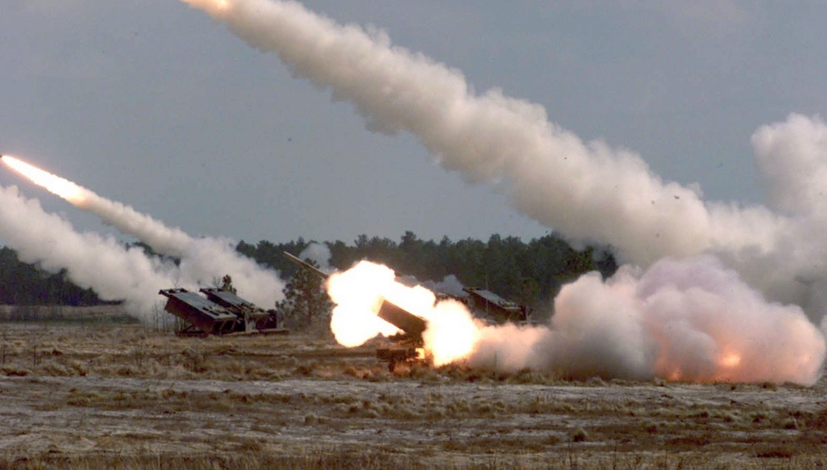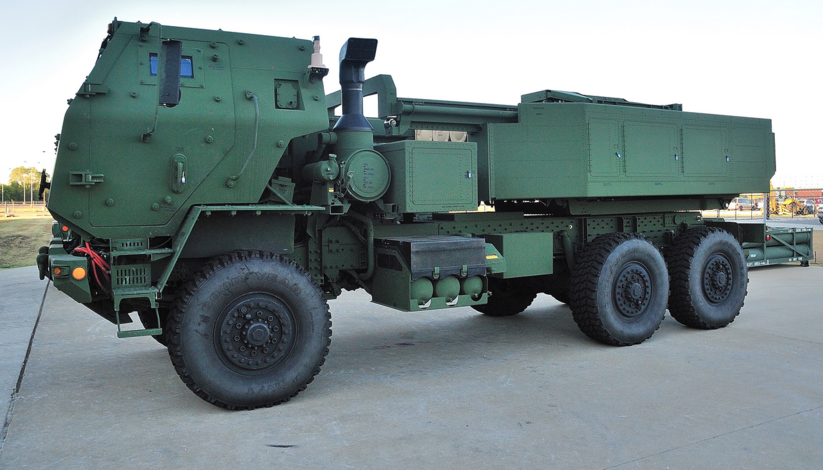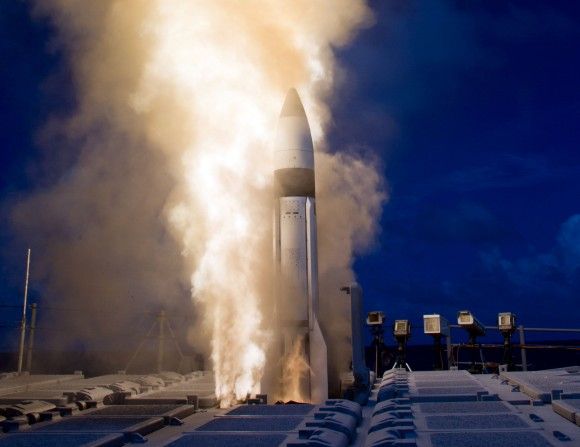HIMARS - Lockheed Martin’s Offer for Homar Missile System
Switching from HIMARS to HOMAR is pretty natural - as it was stated by Frederick Clarke, one of the representatives of the Lockheed Martin Company. Within the scope of the Homar (Pol. for Lobster) missile programme, the US Company offers the HIMARS wheeled-chassis launchers, along with a precision-guided munitions system, consisting of the GMLRS guided rockets with a range of 70 kilometres, and ATACMS ballistic missiles which are capable of striking targets at distances of up to 300 kilometres. The systems developed within the scope of the Homar programme are to be introduced into use in the Polish Army as early as in 2018.
The programme, the aim of which is to acquire a “Squadron-level fire-module of multiple rocket launchers” was significantly accelerated, due to the Ukrainian crisis. In its basic assumption, the initiative is to provide the Polish Army with a capability of striking targets at distances of up to 300 km. Similarly as the JASSM missiles, purchased in December 2014, the HOMAR initiative constitutes an element of the “Polish Claws” programme, the aim of which is to create deterrence potential, which would be composed out of missiles launched from air, maritime and land platforms.
Spokesperson for the Polish Ministry of Defence, Col. Jacek Sońta, stated in March this year, that the relevant negotiations were to begin in early June 2015. Currently, according to the “Armed Forces Technical Modernization Plan For The Period Between 2013 and 2022”, at the request of the potential contractor (HSW S.A.), the negotiations deadline is expected to be postponed until 31st August 2015. The contract is to be signed within the last quarter of 2015. According to the assumed schedule, the first launchers are going to be delivered for the units of the Polish Army between 2017 and 2018. The launchers would be stationed, inter alia, in the eastern area of Poland. According to the statements made by Deputy Minister of Defence, Czesław Mroczek, during the meeting of the Parliamentary National Defence Committee, Homar rocket launchers would constitute armament of, among other elements, the Węgorzewo-based 11th Artillery Regiment, complementing the fire-power of the 155 mm Krab self-propelled howitzers.

Lockheed Martin:Will HIMARS be transformed into Homar?
In March this year, the Armament Inspectorate sent an invitation letter to the Stalowa Wola Ironworks (Huta Stalowa Wola, HSW S.A.). The Ministerial organ invited the plant to take part in the procedure, the aim of which is to procure a “Squadron-level fire module of multiple rocket launchers”, also known as Homar. Lockheed Martin Company had initiated a partnership earlier, regarding the process of tailoring the HIMARS system, to the requirements of the Polish Homar programme.
We believe that switching from HIMARS to HOMAR is pretty natural. HIMARS is not a research project but rather a combat proven, state-of-the-art product. The system is mature but not over-mature because ATACMS, GMLRS, and HIMARS are advanced solutions. HIMARS and GMLRS were used operationally for the first time in 2005. Thus for 10 years they have been used in combat operations. The system was deployed to Iraq and Afghanistan among other places, not only by the American forces, but also by their allies who operate GMLRS missiles. Therefore these are combat proven capabilities and a “low-risk” proposal for Poland
The WR-300 Homar research and development programme, initiated back in 2007, assumed that the Polish Army would be equipped with launchers capable of striking targets at distances of up to 60 kilometres, with the use of salvo-launched rockets. Additionally, the system was also to facilitate employment of tactical missiles, with a range of 150 up to 300 kilometres.
HIMARS constitutes the next step in evolution of the M270 MLRS (Multiple Launch Rocket System) launchers, designed by the Lockheed Martin Company. This system is being used by NATO member states and other US allies. Heavy M270 launcher is based on the M993 chassis, also used by the M2 Bradley IFV. The system is still being actively used by more than 12 states, including the United States of America. Its basic armament – 12 GMLRS rockets – are placed within two modules installed on the carrier vehicle. The M270 platform is able to utilize a wide variety of guided and unguided munitions, at distances of up to 70 kilometres. Alternatively, the launcher may carry two ATACMS ballistic missiles, range of which reaches 300 kilometres.

M142 HIMARS (High Mobility Artillery Rocket System) is a lighter mobile variant of the above system, developed by the Lockheed Martin Company. The system consists of a single six-rail MLRS module based on a high mobility Army Medium Tactical Vehicle (MTV) 6-wheeled chassis, manufactured by the British BAE Systems company. The vehicle features self-loading system, fire control system, and it is capable of utilizing the same, full range of rockets and missiles that are used with the M270 launchers. The wheeled-chassis launcher has greater mobility, it may also be airlifted by the C-130 Hercules aircraft.
A mobile launcher needs less than 60 seconds from obtaining a fire order to launch its rockets. HIMARS features the shoot-and-scoot capability. It can be displaced immediately after launching its rockets and reloaded for another launch. Due to the on-board self-loading system, reloading of the launcher is quick and does not require any additional vehicles, cranes or other equipment, no matter whether we use GMLRS rockets or ATACMS missiles
HIMARS launcher is operated by a crew of three, however, it may also be manned by a single person in case of an emergency. When it comes to the variant offered for Poland, the launcher is going to be based on a Jelcz truck chassis. Fire control system is to be fully compatible with the automated ZZKO Topaz command and control system, utilized at the squadron level.
Stalowa Wola Ironworks, the leading company of the Homar programme, assures that results of the programmes financed by the National Centre for Research and Development, covering the areas of automated fire control and command system for the Kryl and Langusta systems, are also going to be utilized in the works on the new armament platform. The Homar launcher is going to be manufactured by a consortium consisting of Stalowa Wola Ironworks, Grudziądz Military Armament Plant, Mesko SA and WB Electronics. Lockheed Martin Company cooperates with all of the above-mentioned subjects, within the scope of the Homar programme.
GMLRS Missiles
Lockheed Martin’s offer, besides the launcher, also includes two types of munitions. The targets located within the range between 15 up to 70 kilometres may be destroyed with the use of six-rail GMLRS (Guided Multiple Launch Rocket System) launchers. According to the statements made by Lockheed Martin, the system is capable of striking the targets precisely, with a 90 kilogram warhead, with a limited risk of collateral damage. Up until now, 3000 rockets of this time were used in combat conditions.
GMLRS Unitary is referred to by soldiers as the „70 kilometer sniper rifle”. On the other hand the Alternative Warhead provides engagement of area targets, replacing cluster ammunition with the similar hit accuracy. It provides similar area effects but without the risk of leaving dangerous duds. This type of projectile is very efficient in engaging such targets as radar, anti-aircraft systems, command posts, troops and light armored vehicles of ammunition and supply storage areas. It complements the currently operated GMLRS Unitary projectiles that provide precision point-hits with a minimized risk of collateral damage. (…) Poland has the potential for developing and manufacturing its own warheads dedicated to specific missions. However, the basic question is how soon they can be used in the HIMARS system. As soon as requirements of Polish MoD are known, we will be able to consider some proposals designed to meet them
The US offer does not include the cluster munitions, sales and use of which are criticized by the UN. In Europe, the MLRS and GMLRS missile systems are utilized, inter alia, by Germany, France, Italy, Turkey or the UK. Finland also procured Dutch and Danish M270 MLRS systems recently. Lockheed Martin company helped the Finns to upgrade the launchers, up to the standard which has the precision strike capabilities, provided by the GMLRS and ATACMS ordnance.

ATACMS – Tactical missile – range of 300 km
ATACMS is a tactical missile system capable of striking targets at distances of up to 300 km. According to the initial assumptions, rockets with a similar range (limited by the international armament trade memorandums) that are to be one of the basic projectiles of the Homar system, are going to be an element of so called “Polish Claws”, which are to become the means of deterrence, by providing a capability of carrying our precision strikes far behind the enemy lines.
According to the statements made by Lockheed Martin, ATACMS missiles are guided with the GPS-enhanced INS guidance system, which makes it possible for them to strike targets with their 230 kg warhead with accuracy deviation which is smaller than 100 meters. The pods used to carry the ATACMS missiles are visually identical to those used to carry the GMLRS ordnance, the launchers are used as the carrier vehicle. The HIMARS system is capable of carrying a single ATACMS missile, it may be self-loaded, without any additional vehicles. The precision strike may be conducted quickly, right after the unit receives the relevant orders.
ATACMS is very effective for deep attack missions and targets. This is not a slow and low-flying cruise missile but rather a fast strike precision weapon. Time of flight to target over a distance of 300 km is very short, useful in engaging time-critical targets. The missile attacks with exceptional precision and destructive power while limiting collateral damage
According to Clarke, the system consisting of the HIMARS launcher, complemented by the GMLRS and ATACMS missiles, makes it possible to strike a wide variety of targets at distances between 15 and 300 kilometres. So far, 480 HIMARS launchers were delivered. More than 3 thousand GMLRS and 540 ATACMS missiles were launched.
The system has been serially-produced for a decade now. Representatives of the Lockheed Martin company indicate that the time which needs to pass, until the system is introduced into use, is largely dependent on the scope and process of cooperation with the Polish industry, particularly referring to the integration processes related to the Jelcz vehicle and ZZKO Topaz command and control system. In the standard mode of acquisition, HIMARS launchers may be delivered within the term of 18-24 months. Thus, potentially, there is a chance of realizing the deliveries between 2017 and 2018, assuming that the agreement would be signed until the end of the year, in line with the plan which is to be realized by the Polish Ministry of Defence. The manufacturer claims it is interested in extensive partnership with Polish industry that covers development of the Homar system and tailoring it to the needs of a local user, and perhaps also future solutions born this way.







